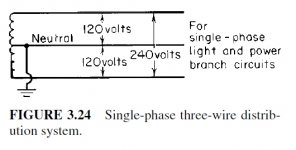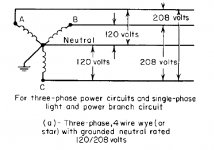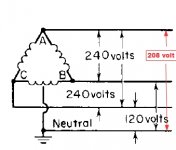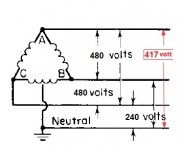Bertsbolts
Member
- Location
- Florida
- Occupation
- Production Engineer - Heating, Cooling and Electrical Control Systems
In my shop, we have a rotary phase converter (15 HP Idler RPC).to bring our 240VAC 1Ph to 460VAC 3 Phase, The voltage is first stepped up from 240V to 460V through a single phase transformer. Then it is passed through a fused disconnect to a rotary phase converter. This same Disconnect is also where we tap the 3 phase with a cable to test run 460V 3Ph Condensers. The problem I am having is that I have a very high leg on the manufactured line. With some of the new equipment, electronic monitors/controls exist, and I am suspicious that the uneven voltage is a cause of loss of phase trips on, say, a Scroll Compressor monitor or phase monitor. On typical machine motors we experience little problem.
Currently I have the transformer tapped to boost from 240V to 464V (single phase). After the rotary phase converter, my voltage readings are as follows-
L1 - L3 = 462V, L1 - L2= 515V, L2 - L3= 532V. (Though not a common measurement, to Ground L1=242V, L2=385V, L3=242V ) Amperage readings on a served motor from the converter usually shows around 1/2 the amps on L2.
The Rotary phase converter does contain a start capacitor (50mfd) and a run capacitor (80mfd).
Questions: Is the solution to better equalizing the voltage a matter of placing capacitors across L1-L2 and L2-L3?
Can someone point me to the proper equation for figuring the mfd sizing, if so?
Aside from purchasing an expensive control attachment from the OEM, I am trying to just utilize this piece of equipment as best possible, until we upgrade our facility electric service and go to digital converters. All suggestions considered. Thanks in advance for the help.
I do have one other question concerning transformers and phase converters.
Can a three phase step up transformer be used safely/effectively fed from the outputs of a digital phase converter? 240VAC output stepped to 460VAC.(For single point load)
Thanks again
Currently I have the transformer tapped to boost from 240V to 464V (single phase). After the rotary phase converter, my voltage readings are as follows-
L1 - L3 = 462V, L1 - L2= 515V, L2 - L3= 532V. (Though not a common measurement, to Ground L1=242V, L2=385V, L3=242V ) Amperage readings on a served motor from the converter usually shows around 1/2 the amps on L2.
The Rotary phase converter does contain a start capacitor (50mfd) and a run capacitor (80mfd).
Questions: Is the solution to better equalizing the voltage a matter of placing capacitors across L1-L2 and L2-L3?
Can someone point me to the proper equation for figuring the mfd sizing, if so?
Aside from purchasing an expensive control attachment from the OEM, I am trying to just utilize this piece of equipment as best possible, until we upgrade our facility electric service and go to digital converters. All suggestions considered. Thanks in advance for the help.
I do have one other question concerning transformers and phase converters.
Can a three phase step up transformer be used safely/effectively fed from the outputs of a digital phase converter? 240VAC output stepped to 460VAC.(For single point load)
Thanks again





